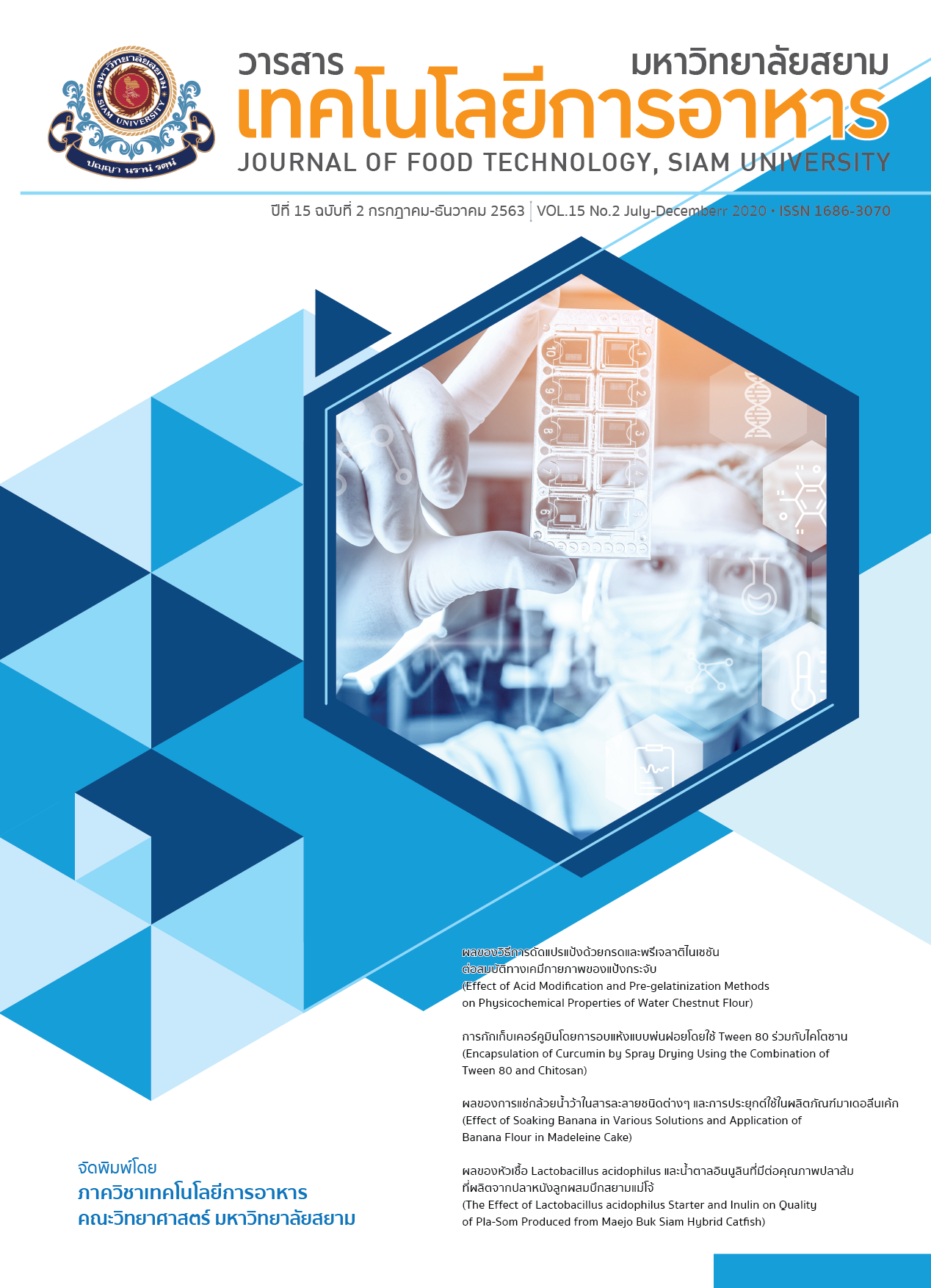Optimum Conditions of Instant Mulberry (Murus alba L.) Powder Production by Foam-mat Drying
Main Article Content
Abstract
The aim of this work was to optimize condition for producing the instant mulberry powder by using a foam-mat drying method. The optimum conditions for mulberry foam production were using 1.5% w/w methocel and whipping time for 20 minutes. The density, expansion and stability of foam from this condition were 0.41 g/cm3, 951.89% and 184.18 ml., respectively. The optimum condition for drying was 60 °C for 90 minutes. The chemical and physical properties of instant mulberry powder per 100 g showed that the moisture content was 7.01%, water activity (aw) was 0.30, and pH was 4.94. The protein, total fat, and total carbohydrate contents were 1.5 g, 0.23 g, and 88.90g, respectively. The total energy was 363.67 Kcal/100 g. Anthocyanin content was 123.15 mg /100g. Ash content was 1.42 g /100 g. Rehydration of instant mulberry powder was 83.54%. The total soluble solid was 5.33 °Brix. The brightness (L*) 44.72, redness (a*) 15.96, yellowness (b*) 2.71 and hue angle were 0.17. Sensory evaluation was tested by 9-Point Hedonic scale (n = 50). Most sensory consumers accepted the mulberry instant powder dried at 60°C for 90 minutes. The overall liking score was 6.92 with average overall liking scores at moderate level.
Article Details
Copyrights of all articles in the Journal of Food Technology available in print or online are owned by Siam University and protected by law.
References
Duthie, G.G., Duthie, S.J. and Kyle, J. (2000). Plant polyphenols in cancer and heart disease: implications as nutritional antioxidants. Journal of Nutrition. 13: 79-106.
Manach, C., Mazur, A. and Scalbert, A. (2005). Polyphenols and prevention of cardiovascular disease. Journal of Current Opinion in Lipido. 16: 77-84.
Lazee, M.C., Savio, M., Pizzala, R., Cazzalini, O., Perucca, P., Scovassi, A.I., Stivala, L.A. and Bianchi, L. (2004). Anthocyanins induce cell cycle perturbations and apoptosis in different human cell lines. Journal of Carcinogenesis. 25: 1427-1433.
Kaewreuang, W. (2012). Mulberry fruit pharmacy. D-Library | National Library of Thailand. [Online] Available from from http://164.115.27.97/digital/items/show/7656 [Accessed July 16, 2020.
Khangrahad, C., Thongteerapharb, W., Saengsoda,T. and Onchaliaw, P. (2017). The Success factors for mulberry business and agriproduct processing: a case of Ban Suan Farm, Mae Aui Bang-Lan District, Nakhon Pathom Province. Proceedings of the The 4th National Conference on Public Affairs Management Public Affairs Management Under Thailand 4.0, pp 755-770. August 4, 2017. Khon kaen, Thailand.
Leelahemaratana, S. and Tongchitpakdee, S. (2011). Chemical composition and radical scavenging activity of mulberry pomace. Proceedings of 49th Kasetsart University Annual Conference: Agro-Industry, pp 548-555. February 1-4, 2011. Bangkok, Thailand.
Intipunya, P. and Thamee, T. (2014). Effects of spray drying process on quality of mulberry-honey mixed powder. Thai Agricultural Research Journal. 32(2): 139-153.
Pomkong, W. (2009). The study of foam-mat tamarind drying process. Faculty of Agriculture, Ubon Ratchathani University. Ubon Ratchathani, Thailand.
Thuwapanichayanan, R., Soponronnarit, S. and Prachayawarakorn, S. (2008). Drying characteristics and quality of banana foam mat. Journal of Food Engineering. 86(4): 573-583.
Praserd, W. (2013). Foam mat drying technique. Food Journal (Thailand). (43)3: 23-26.
Tuladilok, K. and Rattanapitigorn, P. (2009). Production of pickled garlic powder by foam-mat drying. Published master’s thesis, Chiang Mai University. Chiang Mai, Thailand.
Caliskan, G. and Dirim, S.N. (2016). The effect of different drying processes and the amounts of maltodextrin addition on the powder properties of sumac extract powders. Journal of Powder Technology. 287: 308–314.
Bopitsuwan, R. and Rojanakorn, T. (2017). Effects of maltodextrin on some physical characteristicsof foam-mat dried gac aril powder. Proceedings of the National and International Graduate Research Conference 2017, pp 467-474. March 10, 2017. Khon Kaen University. Khon Kaen, Thailand.
Chaovanalikit, A. and Ittisophonkun, T. (2011). Natural colorants from mangosteen rinds. unpublished research. Srinakharinwirot University. Bangkok, Thailand.
Ngamsanga, S., Laohakunjit, N. and Kerdchoechuen, O. (2015). Effect of foaming agent on characterization of banana (kluay hom tong) by foam-mat drying. Agricultural Science Journal. 46(3)(Suppl.): 429-432.
Auisakchaiyoung T and Rojanakorn T. (2015). Effect of foam-mat drying conditions on quality of dried gac fruit (Momordica cochinchinensis) aril. International Food Research Journal. 22: 2025-2031.
Karim, A.A. and Wai, C.C. (1999). Characteristics of foam prepared from star fruit (Averrhoa carambola L.) puree by using methyl cellulose, Food Hydrocolloids. 13: 203-210.
Durian, D.J. (1995). Foam mechanics at the bubble scale. Physical Review Letters. 75(26): 4,780-4,783.
Krasaekoopt, W. and Bhatia, S. (2012). Production of yogurt powder using foam-mat drying. Assumption University Journal Technology. 15(3): 166-171.
Association of Official Analytical Chemists (AOAC). (2016). Official methods of analysis of the association of official analytical chemists. Washington D.C., USA.
Chaovanalikit, A. (2011). Extraction and analysis of anthocyanin. Srinakharinwirot University (Journal of Science and Technology). 3(6): 26-36.
Rardniyom, C. (2002). Production of longan juice powder by foam-mat drying. Unpublished master’s thesis, Chiang Mai University. Chiang Mai, Thailand.
Hart, M.R., Graham, R.P., Ginnette, L.F. and Morgan, A.I. (1963). Foams for foam-mat drying. Food Technology. 17: 1302-1304.
Fellow, P. (2000). Food processing technology principles and practice. 2nd ed. Abington: Woodhead Publishing Limited.
Sarochwikasit, S. and Tangduangde, C. (2011). Effect of drying temperature and drying aids on qualities of spray dried pineapple juice. KMITT Research and Development Journal. 34(3): 203-215.
Kirca, A. and Cemeroglu, B. (2003). Degradation kinetics of anthocyanins in blood orange juice and concentrate. Food Chemistry. 81: 583-587.
Kirca, A. Ozkan, M. and Cemeroglu, B. (2007). Effects of temperature, solid content and pH on the stability of black carrot anthocyanins. Food Chemistry. 100(1): 212-218.


